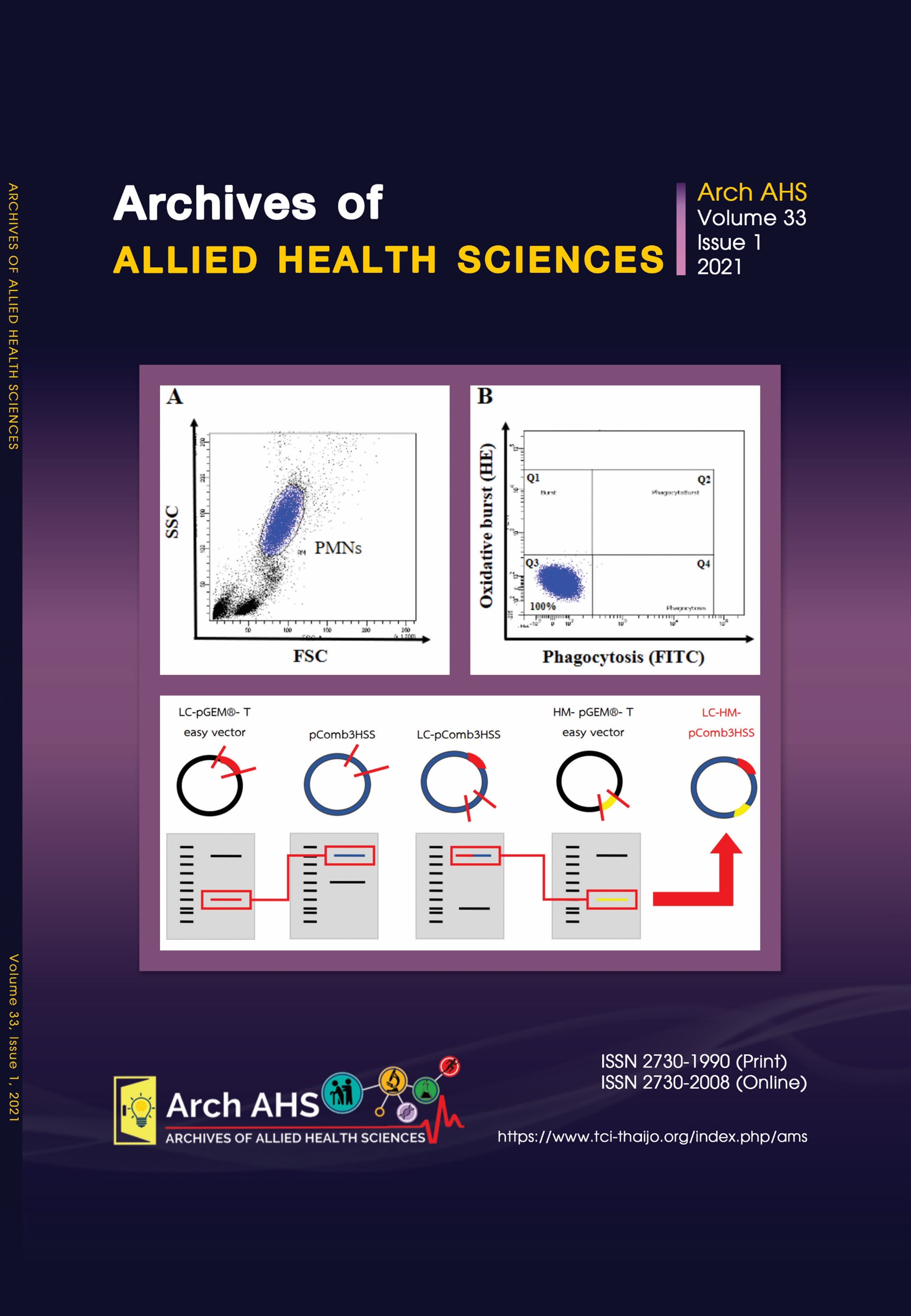Effects of a hip-core warm-up protocol on Q-angle during single-leg drop jump in 18–35 years old healthy female runners
Main Article Content
Abstract
Changing of Q-angle could detect abnormal biomechanics while running especially lower extremity. Increasing the angle can cause knee pain in various runners. Weakness and fatigue of hip-core muscles during exercises are the main factors that alter the angle and contribute to knee pain. Maintaining muscle performance through the running race and improving their strength are benefcial to athletic performance
and decrease the injury rate. Unfortunately, there is no evidence of effectiveness of hip–core warm-up affects the Q-angle. The study aimed to investigate the effects of a hip–core warm-up protocol on the Q-angle during single-leg drop jump in 18–35 years old healthy female runners. Twenty-eight healthy female runners at the age of 18–35 participated and were randomly assigned to the exercise and control groups, fourteen in each. All runners performed pre-warm-up, post-warm-up and post-exercise single-leg drop jump test and the Q-angle was recorded by video cameras. The exercise group was assigned to have the hip–core warm-up protocol and the warm-up protocol for runners, while the control group was assigned to have only the warm-up protocol for runners. The results were compared within testing conditions and between two groups. In the exercise group, the result demonstrated that the Q-angle after warm-up programs was signifcantly decreased and was slightly increased after the 30-minute treadmill running. In the control group, this angle did not show any change. However, after 30-minute treadmill running, the angle showed a considerable increase and reached more than both pre-warm-up and post-arm-up angles. When compared between groups, the Q-angle was not altered signifcantly in any comparable. In conclusion, the hip-core warm-up protocol could immediately decrease the Q-angle and maintain the angle though 30-minute running. In contrast, the warm-up routine program could not decrease the angle, and it was higher than pre-warm up after fnishing treadmill running. So, professionals should advise the hip-core warm-up protocol to reduce the risk of knee injuries in the runner.
Article Details

This work is licensed under a Creative Commons Attribution-NonCommercial-NoDerivatives 4.0 International License.
References
Cook C, Mabry L, Reiman MP, Hegedus EJ. Best tests/clinical findings for screening and diagnosis of patellofemoral pain syndrome: a systematic review. J Physiother 2012; 98(2): 93-100.
Roush JR, Curtis Bay R. Prevalence of anterior knee pain in 18-35-year-old females. Int J Sports Phys Ther 2012; 7(4): 396-401.
Huberti HH, Hayes WC. Patellofemoral contact pressures. The influence of q-angle and tendofemoral contact. J Bone Joint Surg Am 1984; 66(5): 715-24.
Hollman JH, Ginos BE, Kozuchowski J, Vaughn AS, Krause DA, Youdas JW. Relationships between knee valgus, hip-muscle strength, and hip-muscle recruitment during a single-limb step-down. J Sport Rehabil 2009; 18(1): 104-17.
Paz GA, de Freitas Maia M, Santana HG, Miranda H, Lima V, Willson JD. knee frontal plane projection angle: a comparison study between drop vertical jump and step-down tests with young volleyball athletes. J Sport Rehabil 2019; 28(2): 153-8.
Stickler L, Finley M, Gulgin H. Relationship between hip and core strength and frontal plane alignment during a single leg squat. Phys Ther Sport 2015; 16(1): 66-71.
Ferber R, Bolgla L, Earl-Boehm JE, Emery C, Hamstra-Wright K. Strengthening of the hip and core versus knee muscles to treat patellofemoral pain: a multicenter randomized controlled trial. J Athl Train 2015; 50(4): 366-77.
Fradkin AJ, Zazryn TR, Smoliga JM. Effects of warming-up on physical performance: a systematic review with meta-analysis. J Strength Cond Res 2010; 24(1):140-8.
Costa PB, Medeiros HBO, Fukuda DH. Warm-up, stretching, and cool-down strategies for combat sports. Strength Cond J 2011; 33(6): 71-9.
Rice A. Top fve marathon warm-up races. Runner’s World. 2014.
Saez Saez de Villarreal E, Gonzalez-Badillo JJ, Izquierdo M. Optimal warm-up stimuli of muscle activation to enhance short and long-term acute jumping performance. Eur J Appl Physiol 2007; 100(4): 393-401.
Skof B, Strojnik V. The effect of two warm-up protocols on some biomechanical parameters of the neuromuscular system of middledistance runners. J Strength Cond Res 2007; 21(2): 394-9.
Dierks TA, Manal KT, Hamill J, Davis IS. Proximal and distal influences on hip and knee kinematics in runners with patellofemoral pain during a prolonged run. J Orthop Sports Phys Ther 2008; 38(8): 448-56.
Kellis E, Liassou C. The effect of selective muscle fatigue on sagittal lower limb kinematics and muscle activity during level running. J Orthop Sports Phys Ther 2009; 39(3): 210-20.
Gorassini M, Yang JF, Siu M, Bennett DJ. Intrinsic activation of human motoneurons: reduction of motor unit recruitment thresholds by repeated contractions. J Neurophysiol 2002; 87(4): 1859-66.
Lin CY, Tsai LC, Press J, Ren Y, Chung SG, Zhang LQ. Lower-limb muscle-activation patterns during off-axis elliptical compared with conventional gluteal-muscle-strengthening exercises. J Sport Rehabil 2016; 25(2): 164-72.


